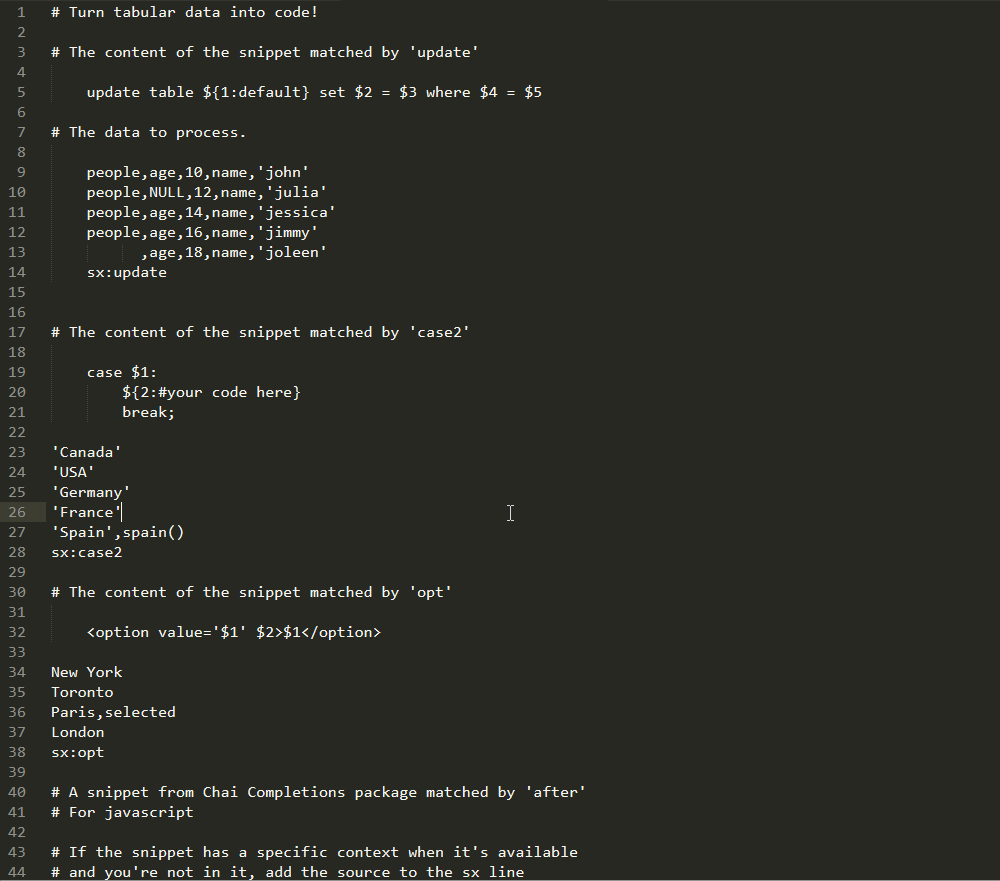SnippetX
A Sublime Text 3 plugin for combining tabular data with snippets
Details
Installs
- Total 2K
- Win 2K
- Mac 336
- Linux 295
| Dec 19 | Dec 18 | Dec 17 | Dec 16 | Dec 15 | Dec 14 | Dec 13 | Dec 12 | Dec 11 | Dec 10 | Dec 9 | Dec 8 | Dec 7 | Dec 6 | Dec 5 | Dec 4 | Dec 3 | Dec 2 | Dec 1 | Nov 30 | Nov 29 | Nov 28 | Nov 27 | Nov 26 | Nov 25 | Nov 24 | Nov 23 | Nov 22 | Nov 21 | Nov 20 | Nov 19 | Nov 18 | Nov 17 | Nov 16 | Nov 15 | Nov 14 | Nov 13 | Nov 12 | Nov 11 | Nov 10 | Nov 9 | Nov 8 | Nov 7 | Nov 6 | Nov 5 | |
|---|---|---|---|---|---|---|---|---|---|---|---|---|---|---|---|---|---|---|---|---|---|---|---|---|---|---|---|---|---|---|---|---|---|---|---|---|---|---|---|---|---|---|---|---|---|
| Windows | 0 | 0 | 0 | 0 | 0 | 0 | 0 | 0 | 0 | 0 | 0 | 0 | 0 | 0 | 0 | 0 | 0 | 0 | 0 | 0 | 0 | 0 | 0 | 0 | 0 | 0 | 0 | 0 | 0 | 0 | 0 | 0 | 0 | 0 | 0 | 0 | 0 | 0 | 0 | 0 | 0 | 0 | 0 | 0 | 0 |
| Mac | 0 | 0 | 0 | 0 | 0 | 0 | 0 | 0 | 0 | 0 | 0 | 0 | 0 | 0 | 0 | 0 | 0 | 0 | 0 | 0 | 0 | 0 | 0 | 0 | 0 | 0 | 0 | 0 | 0 | 0 | 0 | 0 | 0 | 0 | 0 | 0 | 0 | 0 | 0 | 0 | 0 | 0 | 0 | 0 | 0 |
| Linux | 0 | 0 | 0 | 0 | 0 | 0 | 0 | 0 | 0 | 0 | 0 | 0 | 0 | 0 | 0 | 0 | 0 | 0 | 0 | 0 | 0 | 0 | 0 | 0 | 0 | 0 | 0 | 0 | 0 | 0 | 0 | 0 | 0 | 0 | 0 | 0 | 0 | 0 | 0 | 0 | 0 | 0 | 0 | 0 | 0 |
Readme
- Source
- raw.githubusercontent.com
SnippetX
Turn tabular data into code!
SnippetX takes comma-seperated data (csv) and combines it with a snippet of your choosing. It's like xarg but for snippets.
Demo

Installation
Download it using Package Control.
Basic Usage
Place comma-seperated values in your view or open a csv file. At the bottom or top add 'sx:' followed by the tabTrigger of the snippet you'd like to use as show here:
sx:[TAB-TRIGGER-OF-SNIPPET]
Make sure there are newlines between the data you want manipulated and anything else. Hit Alt+x. Each line will replaced with the snippet you chose, with the data from the line placed in the snippet.
What snippets can I use?
With the exception of built in snippets, any snippet that has a tab trigger can be used. Nothing special has to be added to make this work. The snippets you use everyday work fine with SnippetX.
More Details
The snippet are context sensitive by default, but you can use snippets meant for any context. If you want, for example, to use a Javascript snippet in a plain text file, your sx line would look like this:
sx:[TAB-TRIGGER-OF-SNIPPET]:source.js
Where the data ends up depends on it's column number and sublime placeholder. IE, anything in column one maps to placeholder $1. You can use the placeholders out of order or multiple times and you can give them default values, in the event that your data has missing fields. If there are more placeholders than columns then the last few placeholders will be either empty or default values. If there are more columns than placeholders than SnippetX will use only as many columns as there are placeholders (Note that the full line would still be replaced).
License
MIT © Colin Ryan
